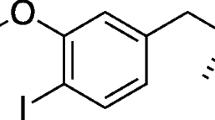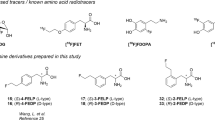Abstract
Purpose
The concentrative amino acid transporter ATB0,+ (SLC6A14) is under evaluation as a target for anticancer therapy. An ATB0,+-selective positron emission tomography (PET) probe could advance preclinical drug development. We characterised the cationic tyrosine analogue O-2((2-[18F]fluoroethyl)methyl-amino)ethyltyrosine ([18F]FEMAET) as a PET probe for ATB0,+ activity.
Procedures
Cell uptake was studied in vitro. ATB0,+ expression was quantified by real-time PCR. [18F]FEMAET accumulation in xenografts was investigated by small animal PET with mice.
Results
[18F]FEMAET accumulated in PC-3 and NCI-H69 cancer cells in vitro. As expected for ATB0,+ transport, uptake was inhibited by LAT/ATB0,+ inhibitors and dibasic amino acids, and [18F]FEMAET efflux was only moderately stimulated by extracellular amino acids. ATB0,+ was expressed in PC-3 and NCI-H69 but not MDA-MB-231 xenografts. PET revealed accumulation in PC-3 and NCI-H69 xenografts and significant reduction by ATB0,+ inhibition. Uptake was negligible in MDA-MB-231 xenografts.
Conclusion
ATB0,+ activity can be imaged in vivo by PET with [18F]FEMAET.






Similar content being viewed by others
References
Ganapathy V, Thangaraju M, Prasad PD (2009) Nutrient transporters in cancer: relevance to Warburg hypothesis and beyond. Pharmacol Ther 121:29–40
Jadvar H, Alavi A, Gambhir SS (2009) 18F-FDG uptake in lung, breast, and colon cancers: molecular biology correlates and disease characterization. J Nucl Med 50:1820–1827
Bodoy S, Fotiadis D, Stoeger C et al (2012) The small SLC43 family: facilitator system l amino acid transporters and the orphan EEG1. Mol Aspects Med 34:638–645
Neels OC, Koopmans KP, Jager PL et al (2008) Manipulation of [11C]-5-hydroxytryptophan and 6-[18F]fluoro-3,4-dihydroxy-L-phenylalanine accumulation in neuroendocrine tumor cells. Cancer Res 68:7183–7190
Langen KJ, Hamacher K, Weckesser M et al (2006) O-(2-[18F]fluoroethyl)-l-tyrosine: uptake mechanisms and clinical applications. Nucl Med Biol 33:287–294
Krämer SD, Mu L, Müller A et al (2012) 5-(2-18F-fluoroethoxy)-l-tryptophan as a substrate of system L transport for tumor imaging by PET. J Nucl Med 53:434–442
Sorensen J, Owenius R, Lax M, Johansson S (2013) Regional distribution and kinetics of [18F]fluciclovine (anti-[18F]FACBC), a tracer of amino acid transport, in subjects with primary prostate cancer. Eur J Nucl Med Mol Imaging 40:394–402
Okudaira H, Nakanishi T, Oka S et al (2013) Kinetic analyses of trans-1-amino-3-[18F]fluorocyclobutanecarboxylic acid transport in Xenopus laevis oocytes expressing human ASCT2 and SNAT2. Nucl Med Biol 40:670–675
Karunakaran S, Ramachandran S, Coothankandaswamy V et al (2011) SLC6A14 (ATB0,+) protein, a highly concentrative and broad specific amino acid transporter, is a novel and effective drug target for treatment of estrogen receptor-positive breast cancer. J Biol Chem 286:31830–31838
Sloan JL, Mager S (1999) Cloning and functional expression of a human Na+- and Cl−-dependent neutral and cationic amino acid transporter B0+. J Biol Chem 274:23740–23745
Hatanaka T, Haramura M, Fei YJ et al (2004) Transport of amino acid-based prodrugs by the Na+- and Cl−-coupled amino acid transporter ATB0,+ and expression of the transporter in tissues amenable for drug delivery. J Pharmacol Exp Ther 308:1138–1147
Ganapathy ME, Ganapathy V (2005) Amino acid transporter ATB0,+ as a delivery system for drugs and prodrugs. Curr Drug Targets Immune Endocr Metabol Disord 5:357–364
Karunakaran S, Umapathy NS, Thangaraju M et al (2008) Interaction of tryptophan derivatives with SLC6A14 (ATB0,+) reveals the potential of the transporter as a drug target for cancer chemotherapy. Biochem J 414:343–355
Chiotellis A, Müller A, Weyermann K, et al. (2013) Synthesis and preliminary biological evaluation of O-2((2-[18F]fluoroethyl)methylamino)ethyltyrosine ([18F]FEMAET) as a possible cationic amino acid PET tracer for tumor imaging (submitted)
Livak KJ, Schmittgen TD (2001) Analysis of relative gene expression data using real-time quantitative PCR and the 2(-Delta Delta C(T)) Method. Methods 25:402–408
Verrey F, Closs EI, Wagner CA et al (2004) CATs and HATs: the SLC7 family of amino acid transporters. Pflug Arch Eur J Physiol 447:532–542
Deves R, Boyd CA (1998) Transporters for cationic amino acids in animal cells: discovery, structure, and function. Physiol Rev 78:487–545
Kanai Y, Segawa H, Miyamoto K et al (1998) Expression cloning and characterization of a transporter for large neutral amino acids activated by the heavy chain of 4F2 antigen (CD98). J Biol Chem 273:23629–23632
Kanai Y, Fukasawa Y, Cha SH et al (2000) Transport properties of a system y+L neutral and basic amino acid transporter. Insights into the mechanisms of substrate recognition. J Biol Chem 275:20787–20793
Comer JEA (2007) Ionization constants and ionization profiles. In: Van de Waterbeemd H, Testa B (eds) Comprehensive medicinal chemistry II. Elsevier, Oxford, pp 357–397
McConathy J, Zhou D, Shockley SE et al (2010) Click synthesis and biologic evaluation of (R)- and (S)-2-amino-3-[1-(2-[18F]fluoroethyl)-1H-[1,2,3]triazol-4-yl]propanoic acid for brain tumor imaging with positron emission tomography. Mol Imaging 9:329–342
Sai KKS, Huang C, Yuan L et al (2013) 18F-AFETP, 18F-FET, and 18F-FDG imaging of mouse DBT gliomas. J Nucl Med 54:1120–1126
Ryazanova OA, Voloshin IM, Makitruk VL et al (2007) pH-induced changes in electronic absorption and fluorescence spectra of phenazine derivatives. Spectrochim Acta A Mol Biomol Spectrosc 66:849–859
Tomé AC (2004) Product class 13: 1,2,3-triazoles. In: Stor R, Gilchrist T (eds) Science of synthesis, vol 13. Georg Thieme, Stuttgart, pp 415–601
Gupta N, Miyauchi S, Martindale RG et al (2005) Upregulation of the amino acid transporter ATB0,+ (SLC6A14) in colorectal cancer and metastasis in humans. Biochim Biophys Acta 1741:215–223
Gupta N, Prasad PD, Ghamande S et al (2006) Up-regulation of the amino acid transporter ATB0,+ (SLC6A14) in carcinoma of the cervix. Gynecol Oncol 100:8–13
Pandini G, Genua M, Frasca F et al (2007) 17beta-estradiol up-regulates the insulin-like growth factor receptor through a nongenotropic pathway in prostate cancer cells. Cancer Res 67:8932–8941
Kaiser U, Hofmann J, Schilli M et al (1996) Steroid-hormone receptors in cell lines and tumor biopsies of human lung cancer. Int J Cancer 67:357–364
Samluk L, Czeredys M, Skowronek K, Nalecz KA (2012) Protein kinase C regulates amino acid transporter ATB0,+. Biochem Biophys Res Commun 422:64–69
Chiotellis A, Mu L, Müller A et al (2013) Synthesis and biological evaluation of 18F-labeled fluoropropyl tryptophan analogues as potential PET probes for tumor imaging. Eur J Med Chem 70C:768–780
Acknowledgments
We thank Romana Meletta for the technical help with the RNA isolation and cDNA preparation.
Conflict of Interest
The authors declare that they have no conflict of interest.
Author information
Authors and Affiliations
Corresponding author
Rights and permissions
About this article
Cite this article
Müller, A., Chiotellis, A., Keller, C. et al. Imaging Tumour ATB0,+ Transport Activity by PET with the Cationic Amino Acid O-2((2-[18F]fluoroethyl)methyl-amino)ethyltyrosine. Mol Imaging Biol 16, 412–420 (2014). https://doi.org/10.1007/s11307-013-0711-2
Received:
Revised:
Accepted:
Published:
Issue Date:
DOI: https://doi.org/10.1007/s11307-013-0711-2




